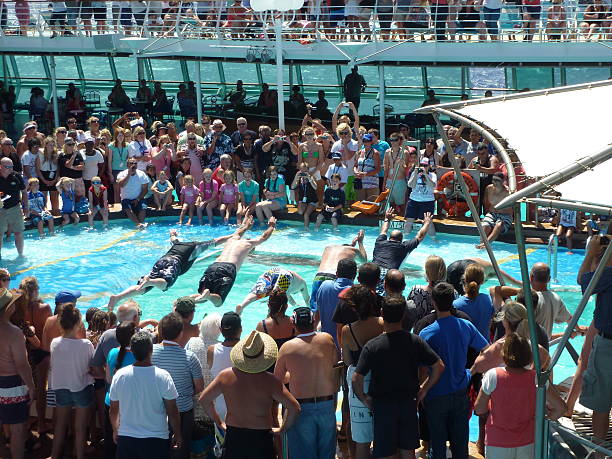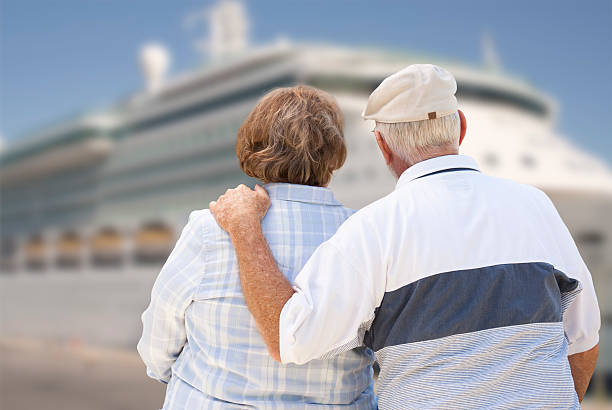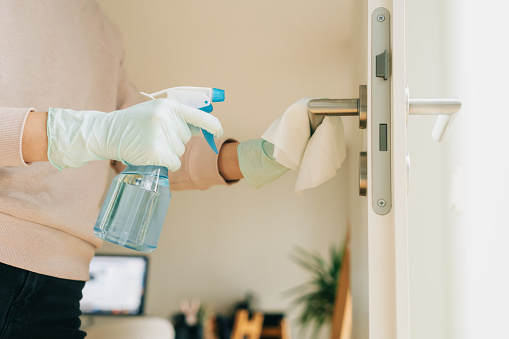Data shows that there were far more cases of Covid-19 on cruise ships than have been reported, but the companies and the CDC have yet to establish how the boats can come back.

W Bradford Gary spent 10 days trapped inside a cruise ship cabin off the coast of Brazil in March while health authorities in several countries scrambled to figure out what to do with a vessel full of older people who had potentially been exposed to the coronavirus.
But when faced with the question of whether he’d ever cruise again, he didn’t hesitate.
“We are very anxious to get back on board,” he said, and he thinks he’s not alone: “There are people like us who want to do this.”
Gary, 70, a retired corporate executive who lives in Palm Beach, Florida, imagines the cruise ship of the near future equipped with special disinfecting ultraviolet lights and air flow contraptions commonly used in sterile laboratories. He envisions larger cabins, fewer passengers and a lot more outdoor spaces. “We want to know everything is safe,” he said.
That is a big order.
With more than 20 million passengers a year, the $45 billion (about R757 billion) global cruise industry has a particularly vexing challenge: its most loyal customers, older people, also happen to be the key demographic at risk for the new illness that has swept the planet. Cruises also have the very things that help the coronavirus spread: large gatherings, confined spaces and workers who live in tight shared quarters.
More than three months after the Centres for Disease Control and Prevention (CDC) issued a no- sail order for all US cruises, interviews with health officials, loyal passengers, industry experts, cruise executives and maritime lawyers made clear that restarting operations would require rethinking cruising itself – from the number of passengers onboard to how they are fed, housed and entertained – and that the government and the cruise lines are not close to figuring it out.

Pier 92 (centre) is part of the Manhattan Cruise Terminal, from which ocean-going ships depart. It is now closed while the no-sail order is in place. Picture: Chang W Lee / The New York Times
The Cruise Lines International Association, the cruise industry’s trade group, said on 19 June that it was voluntarily extending the no-sail period from US ports to 15 September. Earlier, Carnival Corp, the world’s biggest cruise company, had suggested that it could start sailings by 1 August.
According to Martin Cetron, the CDC’s director of the Division of Global Migration and Quarantine, cruise ships offer fertile ground for the “seeding, amplification and dissemination” of Covid-19, worsened by the fact that crew members often transfer from one ship to another, taking diseases with them.
Breaking that chain of infection is key.
Bari GolinBlaugrund, a spokesperson for the Cruise Lines International Association, said: “The cruise industry is taking a holistic approach to planning for Covid-19 safety, when sailing is allowed, that would ideally entail a door-to-door strategy beginning at the time of booking through to the passengers’ return home.”
She said cruise ships are already cleaned several times a day, but the industry is using the time off to rethink everything from offshore excursions to enhanced medical capabilities onboard and evacuations.
As for setting out detailed plans for what a post-pandemic cruise might look like, “we’re not there yet,” she said.

A no sail order from the CDC has kept Pier 90, part of the Manhattan Cruise Terminal, empty for months. Picture: Chang W Lee / The New York Times
Lack of self-regulation
The coronavirus hit the cruise industry hard. Passengers were stranded for weeks while people onboard got sick and were quarantined in their staterooms. A Miami Herald analysis showed that at least 80 people died worldwide.
New data from the CDC, released in response to a Freedom of Information Act request by The Times, shows that more than 100 ships in the US jurisdiction alone had outbreaks onboard, sickening nearly 3,000 people, including more than 850 passengers. The CDC’s figures count cases that were “clinically compatible” with Covid-19 but not confirmed in a lab, and hundreds that occurred among crew members after passengers disembarked.
The CDC records show that Carnival, which had 47 ships on which people fell ill across its nine brands, was most affected. Through a spokesperson, Carnival disputed the figures, saying the CDC’s methodology resulted in overcounting. If only cases with a lab confirmation were included, the number of Carnival ships affected would be 15.
Royal Caribbean had 28 ships with coronavirus cases – almost half its fleet.
Only 15 of the 121 cruise ships that entered US waters after 1 March did not have infections onboard, the records show.
Cruise companies and public health officials are still evacuating and repatriating tens of thousands of crew members who have remained at sea as the pandemic rages, the CDC said.
A little more than a week ago, there were still 68 ships at sea with 21,506 crew members onboard in the US jurisdiction alone.

Picture: iStock
The coronavirus marked the first time the agency issued a travel advisory against a particular mode of travel, as opposed to a geographic area, Cetron said. The CDC’s initial advisory, which recommended against cruise travel but did not ban it, was issued on 8 March, after more than 700 people got sick aboard the Diamond Princess in Japan.
The advisory turned into a no-sail order after it became clear that companies were continuing to embark on voyages and that passengers were not cancelling in large numbers, Cetron said. “This situation wasn’t responding to self-regulation,” he said.
When cruises resume, some changes are likely inevitable, such as thermal scanners at terminals to check temperatures, disinfection foggers to clean ships between cruises, and upgraded ventilation systems. Self-serve buffets may be a thing of the past.
The Times asked 10 of the biggest cruise lines to outline their preparations for resuming sailings. Only one, Genting Cruise Lines, a Hong Kong-based company that mostly operates in Asia, agreed to talk about its plans in detail.
While Princess Cruises, part of Carnival Corp, did not respond directly, it posted a seven-page health advisory outlining some of the steps it plans to take, including increasing the temperature of washers and dryers for better disinfection of bedding and towels.
Carnival said it was still too soon to offer any details. Carnival’s chief executive, Arnold W Donald, said he would let medical experts decide whether to require medical clearances for older passengers.
Royal Caribbean’s chief executive, Richard Fain, said in a May earnings call that he planned to unveil a “healthy return to service programme” that would focus on upgraded health screenings for passengers before boarding, as well as new procedures for dealing with infections onboard. But that plan has not yet been released.

Picture: iStock
Arthur L Diskin, who was a Carnival cruise ship doctor for 18 years, said the adjustments will likely be tailored to each company’s market. Longer cruises, for example, tend to have passengers who are much older, so changes should account for that.
“Maybe they don’t have a disco,” he said. “Maybe they adapt to have more outdoor dining venues so people can be adequately spaced.”
But none of those changes address the biggest questions of how to prevent a disease – one that has generally been checked by isolation and social distancing – on cruise ships carrying thousands of passengers expecting to party and enjoy themselves. Will they keep people two metres apart? Will they make them wear masks?
James Walker, a lawyer in Miami whose practice is focused on suing cruise companies, said ships are going to have to seriously examine how much time they spend cleaning ships between voyages. Cruise companies do not make money while in port, and are always eager to head off on another voyage, he said.
A review of the CDC’s preliminary list of affected ships that came to US ports shows that they sometimes ended one cruise and began another on the same day.
One ship, the Carnival Valor, had three back-to-back cruises on which passengers contracted Covid-19. The ship is designed to carry almost 3,000 passengers in 1,487 staterooms. On quick turnarounds, ships come in to port at 7am and head out with new passengers at 4pm.
“There’s never enough time to clean,” Walker said. “And cruise lines all know. It’s not like they bring in professional cleaning crews that do exhaustive work. They use the same cabin attendants who have to be there to greet the guests when they show up.”

Picture: iStock
Golin-Blaugrund, the trade industry spokesperson, said: “Cruise ships are cleaned and sanitised, under normal circumstances, with a frequency that is nearly unparalleled in other settings. Multiple times daily, crews clean and sanitise surfaces known for transmitting germs, such as handrails, door handles and taps. At the end of a voyage and before a new one begins, ships are cleaned completely from top to bottom.”
As part of the industry’s Vessel Sanitation Programme, she said: “Cruise ship crews are trained in sanitation and public health practices, and ships undergo unannounced inspections twice a year.”
Sheri Griffiths, a video blogger who runs CruiseTipsTV, a YouTube channel, with her husband, said the industry also needs to rethink its cancellation policies. In the past, those who cancelled had to forfeit their payments – often thousands of dollars – which could lead people to travel even if they were not feeling good.
“People need to feel that the passengers around them won’t be boarding the ship sick, and they need to know the crew will be held to a high standard of wellness,” Griffiths said.
Princess Cruises’ advisory said it would issue full refunds or credits to passengers who had to cancel because they were not well or had been exposed to the virus.
As for Griffiths: “I will get on a cruise when the CDC says that I don’t have to self-quarantine when I get off a ship.”
For more news your way, download The Citizen’s app for iOS and Android.






